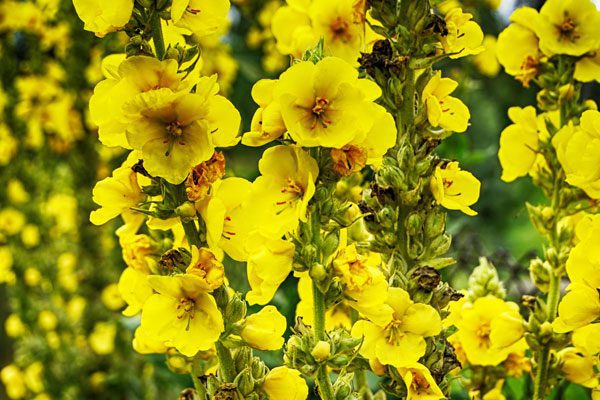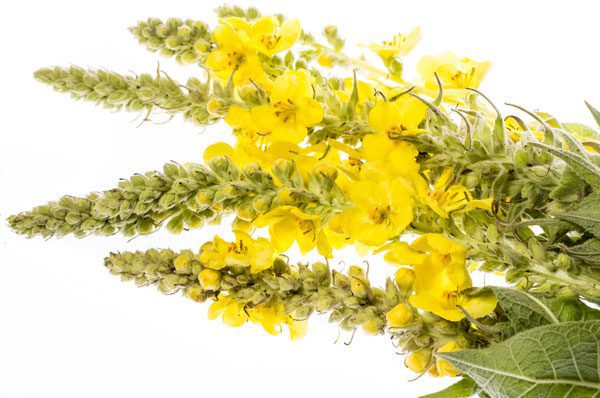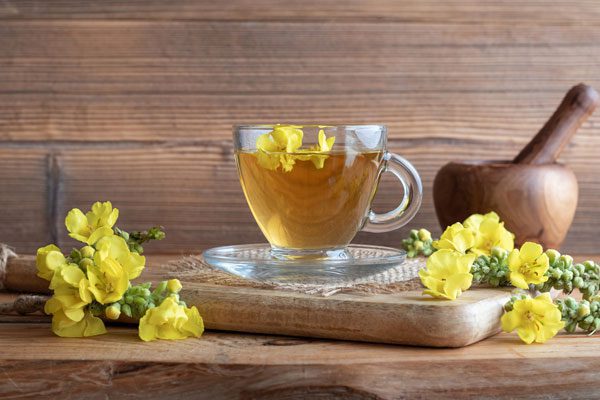You almost can’t miss it; mullein, or Verbascum Thapsus, is a lovely plant with yellow spikes as flowers that can grow up to seven feet tall! The bi-annual weed begins its life cycle as a low-growing rosette with fuzzy, felt-like leaves. Quite the transformation!
Mullein will grow in any soil as long as it has been disturbed; sunny roadsides, ditches, dry open fields, and even burned or logged areas and gardens. If the ground is dry, this robust weed is happy. Each plant can produce up to 175,000 seeds, which remain dormant for decades or hundreds of years. Only once the soil is disturbed will their yellow flowers bloom.

Mullein is considered invasive in many parts of the world and is nearly impossible to eradicate once established. However, this weed has many benefits to our health, making this invader a very welcome friend.
Great mullein, or common mullein, is also referred to as flannel leaf, candlewick plant, and lungwort. In Roman times, the dried stalks were dipped in wax, pine sap, or suet and used as torches. Historically, the plant’s broad leaves were used as insulation in shoes to keep feet warm. And when added to hot water, the flower extract was used as a hair dye for those looking to go golden blonde.
Folklore Medicine

Little modern scientific research has been done on Verbascum Thapsus, but there is some evidence that suggests it can help rid the body of various flu-causing viruses. Further investigation is needed.
In herb lore, however, there is plenty of information concerning the benefits of mullein. This majestic plant has been naturalized all over the world, and several different cultures have used it to develop medicines and remedies.
Almost 2,000 years ago, the Greek physician, pharmacologist, and botanist, Dioscorides, recommended mullein for breathing problems. In Ireland, tea was made from the leaves of the plant to cure lung diseases in both humans and livestock. Native Americans also used mullein for several ailments. The infusion of the leaves was given to babies to regulate their bowels. They used the plant to heal wounds and smoked the leaves to treat a fever, cough, or for ceremonial purposes. During the Civil War, mullein was used as an antiseptic. The leaves were soaked in hot vinegar and water to treat wounds, and they were also made into a tea to soothe a soldier’s lungs.

Mullein is a wonderful ally of the respiratory system. A tea made with the leaves will help reduce inflammation and relax respiratory muscles while also soothing the membranes and relieving dry cough and spasms. Moreover, mullein helps expel mucus and phlegm. Both the leaves and flowers contain mucilage, which is soothing to irritated membranes, and saponins, which make coughs more productive.
The plant helps relax the body and has been used to treat muscle cramps, spasms, and joint pain. Because it helps with swelling and irritation, a strong tea applied as a poultice can help with hemorrhoids.
Mullein has also been used to treat ear infections in both children and adults. The flower’s anti-inflammatory, analgesic, and anti-bacterial properties work wonders in an oil infusion. Warm mullein flower oil soothes pain and helps patients recover quicker.
Earache Mullein Flower Oil
This remedy is simple to make and is an excellent addition to the medicine cabinet. However, it requires patience. Collecting flowers takes time as they don’t bloom all at once on the mullein stalk. While some flowers will open on a given day, others will remain closed. Here’s how to make it:
- Collect as many mullein flowers as you can every day, and then spread them on a paper towel; let them wilt for about half a day. Place the wilted flowers in a glass jar. Cover them with a good quality olive oil and secure a cheesecloth around the top of the jar with an elastic band. Place on a sunny windowsill.
- Add more wilted flowers and oil daily, making sure the plant material is completely covered. When your flower harvest is finished, stir the herbal oil infusion. Add more oil if needed, and put the jar back on the windowsill for at least two weeks so the oil can extract the beneficial properties from the mullein flowers.
- After two weeks, pour the oil through a coffee filter and transfer to a sterilized glass dropper bottle.
- To use, warm the oil by setting the dropper bottle in a cup of hot water. Test the temperature on your wrist before applying three drops to the ear. Seal the ear with a cotton ball and rest for anywhere between five and 15 minutes before allowing the oil to drain.
- NOTE: if you have a ruptured eardrum, do not use ear oil. Consult a physician!
Some might find the plant’s hairs from the leaves and flowers irritate the skin and mucous membranes. For this reason, it is best to strain the tea or the infused oil through a fine-weave cloth or a coffee filter.

Mullein is considered safe, and the roots, flowers, and leaves can be used. However, the seeds should never be ingested, as they contain rotenone and coumarin, which are potentially harmful and toxic. As with all medicinal herbs, it is essential to research and ask a health professional if mullein is suitable for you. If you forage the plant yourself, be sure you know what you’re looking for, as the first-year mullein rosette can be confused with toxic Digitalis (Fox Glove).
Women who are pregnant or nursing should avoid the use of any herbal product containing mullein. The plant should only be used for up to seven days.
are the purple flower mullein plants good as well with the yellow
i have yet to find anything on vining nettle it grows in my garden winding around the fence it has a tri pod seed, can anyone tell me about this kind of nettle?